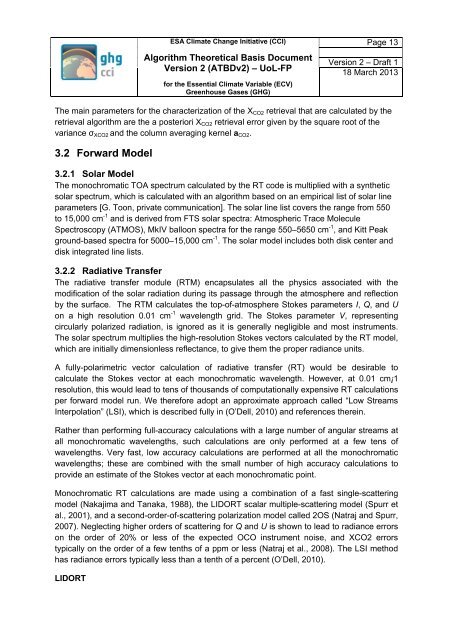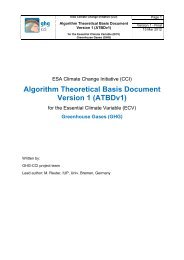ATBD - GHG-CCI
ATBD - GHG-CCI
ATBD - GHG-CCI
Create successful ePaper yourself
Turn your PDF publications into a flip-book with our unique Google optimized e-Paper software.
ESA Climate Change Initiative (<strong>CCI</strong>)<br />
Algorithm Theoretical Basis Document<br />
Version 2 (<strong>ATBD</strong>v2) – UoL-FP<br />
for the Essential Climate Variable (ECV)<br />
Greenhouse Gases (<strong>GHG</strong>)<br />
Page 13<br />
Version 2 – Draft 1<br />
18 March 2013<br />
The main parameters for the characterization of the X CO2 retrieval that are calculated by the<br />
retrieval algorithm are the a posteriori X CO2 retrieval error given by the square root of the<br />
variance σ XCO2 and the column averaging kernel a CO2 .<br />
3.2 Forward Model<br />
3.2.1 Solar Model<br />
The monochromatic TOA spectrum calculated by the RT code is multiplied with a synthetic<br />
solar spectrum, which is calculated with an algorithm based on an empirical list of solar line<br />
parameters [G. Toon, private communication]. The solar line list covers the range from 550<br />
to 15,000 cm -1 and is derived from FTS solar spectra: Atmospheric Trace Molecule<br />
Spectroscopy (ATMOS), MkIV balloon spectra for the range 550–5650 cm -1 , and Kitt Peak<br />
ground-based spectra for 5000–15,000 cm -1 . The solar model includes both disk center and<br />
disk integrated line lists.<br />
3.2.2 Radiative Transfer<br />
The radiative transfer module (RTM) encapsulates all the physics associated with the<br />
modification of the solar radiation during its passage through the atmosphere and reflection<br />
by the surface. The RTM calculates the top-of-atmosphere Stokes parameters I, Q, and U<br />
on a high resolution 0.01 cm -1 wavelength grid. The Stokes parameter V, representing<br />
circularly polarized radiation, is ignored as it is generally negligible and most instruments.<br />
The solar spectrum multiplies the high-resolution Stokes vectors calculated by the RT model,<br />
which are initially dimensionless reflectance, to give them the proper radiance units.<br />
A fully-polarimetric vector calculation of radiative transfer (RT) would be desirable to<br />
calculate the Stokes vector at each monochromatic wavelength. However, at 0.01 cm¡1<br />
resolution, this would lead to tens of thousands of computationally expensive RT calculations<br />
per forward model run. We therefore adopt an approximate approach called “Low Streams<br />
Interpolation” (LSI), which is described fully in (O’Dell, 2010) and references therein.<br />
Rather than performing full-accuracy calculations with a large number of angular streams at<br />
all monochromatic wavelengths, such calculations are only performed at a few tens of<br />
wavelengths. Very fast, low accuracy calculations are performed at all the monochromatic<br />
wavelengths; these are combined with the small number of high accuracy calculations to<br />
provide an estimate of the Stokes vector at each monochromatic point.<br />
Monochromatic RT calculations are made using a combination of a fast single-scattering<br />
model (Nakajima and Tanaka, 1988), the LIDORT scalar multiple-scattering model (Spurr et<br />
al., 2001), and a second-order-of-scattering polarization model called 2OS (Natraj and Spurr,<br />
2007). Neglecting higher orders of scattering for Q and U is shown to lead to radiance errors<br />
on the order of 20% or less of the expected OCO instrument noise, and XCO2 errors<br />
typically on the order of a few tenths of a ppm or less (Natraj et al., 2008). The LSI method<br />
has radiance errors typically less than a tenth of a percent (O’Dell, 2010).<br />
LIDORT




